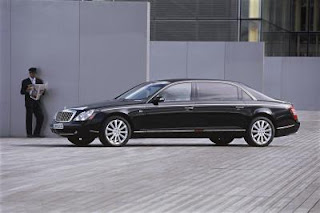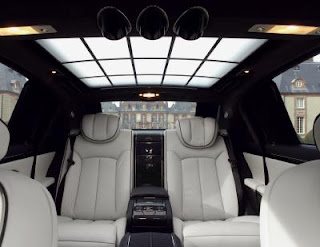Maybach Hasn’t Played Out As Expected
By Chris Haak
10.05.2007
 The recently renamed Daimler AG’s ultra-expensive, ultra-luxurious division, Maybach, was launched with great fanfare in 2002 as a competitor to Rolls-Royce and Bentley. In the late 1990s, DaimlerChrysler decided to resurrect the prewar Maybach name for its new corporate flagships, the 57 and 62 (which refers to the length of the automobiles in decimeters).
The recently renamed Daimler AG’s ultra-expensive, ultra-luxurious division, Maybach, was launched with great fanfare in 2002 as a competitor to Rolls-Royce and Bentley. In the late 1990s, DaimlerChrysler decided to resurrect the prewar Maybach name for its new corporate flagships, the 57 and 62 (which refers to the length of the automobiles in decimeters).
Well, fast forward a few years, and the brand’s cars have NOT been selling well in the US. The company sold 146 cars in 2006, 152 cars in 2005, 244 cars in 2004, 166 cars in 2003. So far in 2007, it has sold 80 cars through August 31, so that means that in the car’s entire existence in the US, it has sold only 788 cars. It makes me feel even more “fortunate” to occasionally spot the one near where I work (I work near a wealthy area, but don’t live in one), since I’ve been seeing it since 2003 or 2004. Contrasting these actual sales results were DaimlerChrysler’s sales projections of 600 units per year. The dealer body was established based on the projection of 600 units annually, but Ernst Lieb, CEO of Mercedes-Benz USA said that 29 of the original 70 US dealers have given up their franchises. Daimler has negotiated compensation packages with the dealers, which – in at least one case – are about 25 cents on the dollar. That means that each dealer will get back about $125,000 of the approximate $500,000 upfront cost to set up a franchise.
 So, what went wrong with the Maybach? They’re certainly comfortable, with every imaginable luxury, including some unimaginable ones like an intercom system to allow vehicle occupants to speak with people outside of the car and rear seats in the 62 that can recline completely flat. The cars are powerful, with engines producing at least 550 horsepower. Well, my guess is that although people in the know can tell what a Maybach is, the cars have the misfortune of looking like unattractive Chinese knockoffs of Mercedes S-class sedans. When the Maybach made its debut, it looked more unique relative to the S-class, but with the introduction of the current W221 S-class sedan, it adopted some of the Maybach 57’s more attractive styling features and is overall a much nicer looking automobile, and can be purchased for less than half the price of a Maybach.
So, what went wrong with the Maybach? They’re certainly comfortable, with every imaginable luxury, including some unimaginable ones like an intercom system to allow vehicle occupants to speak with people outside of the car and rear seats in the 62 that can recline completely flat. The cars are powerful, with engines producing at least 550 horsepower. Well, my guess is that although people in the know can tell what a Maybach is, the cars have the misfortune of looking like unattractive Chinese knockoffs of Mercedes S-class sedans. When the Maybach made its debut, it looked more unique relative to the S-class, but with the introduction of the current W221 S-class sedan, it adopted some of the Maybach 57’s more attractive styling features and is overall a much nicer looking automobile, and can be purchased for less than half the price of a Maybach.
Meanwhile, the guy who bought a Rolls-Royce Phantom (and there were 336 sold in 2006 and 382 sold in 2005 in the US – more than double the Maybach’s sales), for better or worse, never sees himself, or a facsimile of himself, anywhere else in the automotive world.
Frankly, I’m surprised that Mercedes-Benz has bothered to keep pushing the Maybach line. Extremely low sales volumes probably don’t make the car a profitable venture, and the fact that they continue to soldier on with the Maybach brand probably is some combination of German arrogance (the Volkswagen Phaeton is an excellent case study of that trait) and a lack of understanding of sunk costs (“we can’t abandon Maybach after all of the money we’ve spent on it.”)
Regardless of the reason, if I had more money than I knew what to do with, I would not be spending it on a Maybach. I’d probably go for a $186,000 S65 AMG (with basically the same engine that the Maybach has, wrapped in a more attractive body shell and what is still a really nice interior, and perhaps a Ferrari F430 – or even a $75,000 Corvette Z06 – as a sporty second car with the savings.
If I were Dieter Zetsche, I’d drop Maybach as a standalone brand, reach financial settlements with my remaining dealers, and introduce an ultra-luxurious derivative of the S-class and CL-class Mercedes-Benz cars called “Maybach” that captured the essence of the brand (high performance, ultimate luxury, and owner customization) without the need to support an extra brand.
COPYRIGHT Full Metal Autos – All Rights Reserved




